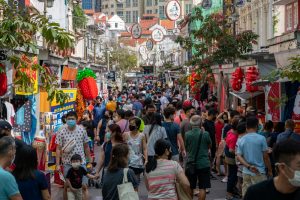A growing number of countries in Southeast Asia are making plans to shift from “zero-COVID” strategies to a policy of living with the disease, even as the highly contagious Delta variant of the coronavirus is propelling new waves of infections across the region.
Indonesia, Malaysia, Thailand, and Vietnam are all reorienting their strategies from pandemic to endemic, taking cues from Singapore’s roadmap announced in June, and others in Europe, the U.K., and the U.S., after months of quasi-lockdowns have failed to quell COVID-19 transmission.
In Indonesia, authorities are reportedly formulating protocols which could see people carry their vaccination cards when they travel.
In Malaysia, newly appointed Health Minister Khairy Jamaluddin outlined the need for long-term plans to manage COVID-19, which would involve regular testing, an extended mask mandate, and home quarantines for those infected with the coronavirus.
The country is expected to move into an endemic phase by the end of October, when 80 percent of its population has been vaccinated.
Thailand began reopening some sectors of the economy, resumed domestic flights, and allowed gatherings of up to 25 people in Bangkok and other high-risk provinces on September 1, as the nation adapts to “coexist safely” with the virus.
Vietnam’s coronavirus epicenter Ho Chi Minh City is also considering a reopening of economic activity from September 15, after Prime Minister Pham Minh Chinh last week announced that the country cannot rely on lockdown and quarantines indefinitely. The reopening aims to “promote economic recovery” in the country’s financial hub, with low-interest loans and tax incentives set to be offered to businesses hit by the epidemic, according to a draft proposal of the plan seen by Reuters.
In theory, the progressive shift to treating the coronavirus as endemic should lead to sustainable ways of managing the disease – strategies that won’t require overly blunt and costly lockdowns. However, in reality, the reality of living with COVID-19 is much more complex.
In recent months, coronavirus cases in highly vaccinated countries like Singapore, the U.S., and Israel have been rising sharply. Singapore is facing an increased likelihood of an exponential rise in COVID-19 infections, while Israel is doubling down on booster shots as new cases rise.
The U.S. now has more states with full mask mandates after the Centers for Disease Control and Prevention reversed its indoor mask policy in July, on the basis of evidence suggesting that vaccinated people infected with the Delta variant may transmit the virus as much as unvaccinated individuals.
Singapore has among the world’s highest vaccination rates, according to data compiled by Our World in Data, with 76 percent of its population fully vaccinated, as of September 5. Israel and the U.S. have fully vaccinated 63 percent and 52 percent of their populations, respectively.
If highly vaccinated nations are grappling with yet another major COVID-19 surge in their trials to live with the virus, a reopening of the economy where the majority of the population remains unvaccinated – as in the case of Indonesia, Thailand, and Vietnam – is even riskier.
In Indonesia, about 24 percent of the 270 million population have received at least one dose of a COVID-19 vaccine to date, and only 14 percent of its population is fully vaccinated.
The country became the epicenter of Asia’s COVID-19 pandemic crisis two months ago after it reported a high 54,517 new cases on July 14. New cases have since fallen, although experts warned that Indonesia is a high-risk hotspot for the emergence of a new coronavirus “super strain.”
Thailand has vaccinated 33 percent of its total population, although the share of fully vaccinated people remains low at 11 percent. Vietnam has among the slowest vaccination rate in Southeast Asia, with less than 3 percent of its total population fully vaccinated.
Malaysia is in a more advantageous position as its COVID-19 vaccine coverage is currently on par with the U.S., with 63 per cent of both populations having received at least one dose. In terms of fully vaccinated population, the U.S. leads with 52 percent versus Malaysia’s 49 percent.
Despite its accelerated inoculation program, Malaysia continues to record the highest number of daily COVID-19 deaths and cases per million people in the region, which proves further that vaccines alone will not stop the coronavirus from spreading.
Other public health measures like contact testing and quick isolation will be key to curbing the virus. Failure to implement effective intervention measures to contain outbreaks could rapidly overwhelm health systems as it did in many parts of Southeast Asia in July.
In other words, living with the virus can be costly. The higher the exposure, the greater the risks. With the region’s health systems still fragile, any miscalculation could prove to be disastrous.

































